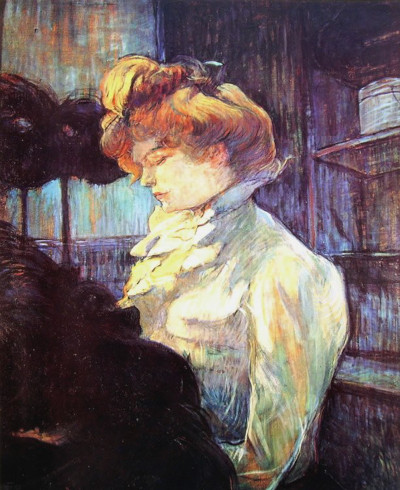La Modiste: Mademoiselle Margouin is a painting by Henri de Toulouse-Lautrec from around the year 1900. It is now a part of the permanent collection of the Musee Toulouse-Lautrec which is based in the south of France.
This piece is around 50cm in height and width, and is a relatively detailed portrait of a woman known to the artist. Mademoiselle Margouin has reddish hair which seemed to attract the artist in how he chose his models, and here she ties it up above her head. The lady sports a white blouse but her lower half is cropped out of the painting (La Modiste: Mademoiselle Margouin). Her expression is serious and her eyes directed downwards. Perhaps she is reading, or deep in thought? The artist lightens her image, whilst leaving the rest of the artwork particularly dark in a manner that was altered from the original moment. He wants to draw our attention to this attractive young woman, with the rest of the details merely serving as supporting elements to the overall composition. There are storage shelves behind her, with perhaps a pot of paint over her left shoulder. Could it be that we are in the artist's studio, as he did complete many portraits within that environment.
The model for this piece has delicate, feminine features which would have appealed to the artist. That said, he was an honest painter who also captured figures within a variety of different circumstances, not all of which were complementary. Her pale skin and auburn hair would have been popular at this time in French society and often his models would be friends and acquaintences who lived nearby. Research into his career has helped to reveal the identities of many of the people who modelled for him, and he would also include men many times as well. The style in which this portrait is executed connects to the earlier Impressionist movement, in how detail is suggested rather than being delivered in a photo realistic manner. This approach remains popular today for those interested in art history and was most common during the mid to late 19th century, particularly in France.
You will find the artist's career laden with female portraits such as this, with other notable examples including the likes of Madame Poupoule at her Dressing Table, Femme Tirant son Bas and also In the Restaurant La Mie. He made use of a variety of people, some of whom would model professionally, whilst others he would come across whilst out and about in Paris. They were also from different backgrounds, and he would sometimes even ask them to pose and act, to match a particular theme that he had in mind at the time. Portraiture was a genre that he truly mastered, but this took many years of study and practice in order to produce items such as the ones described here.




